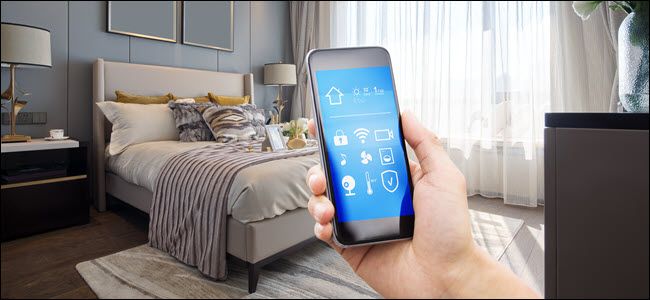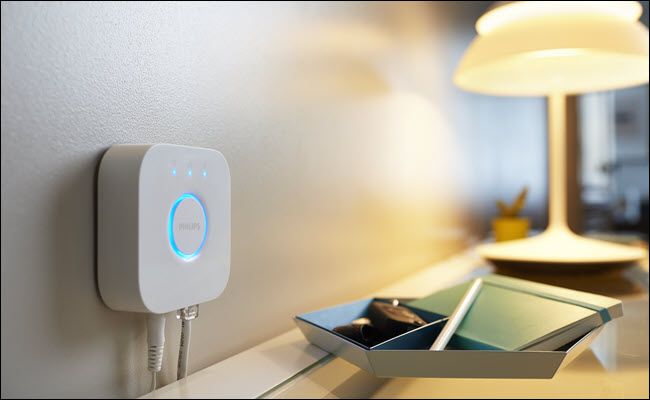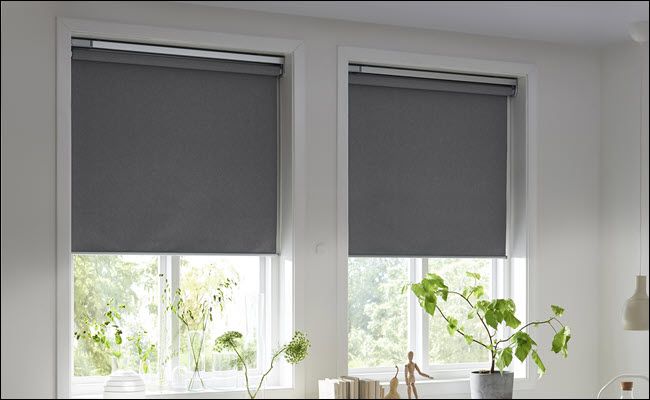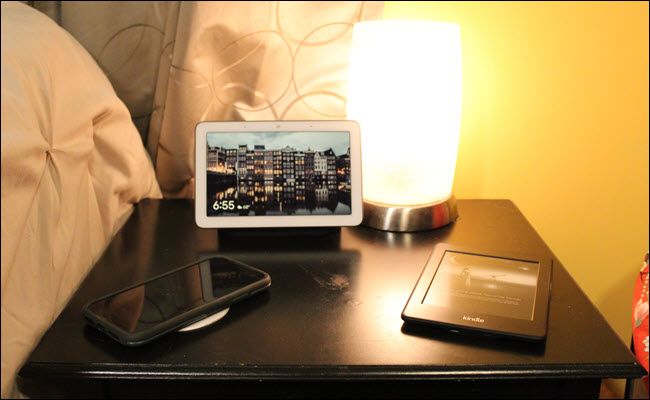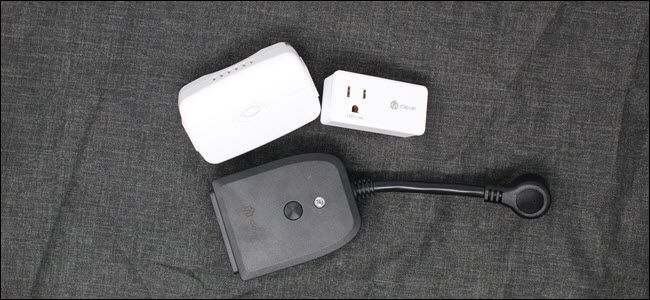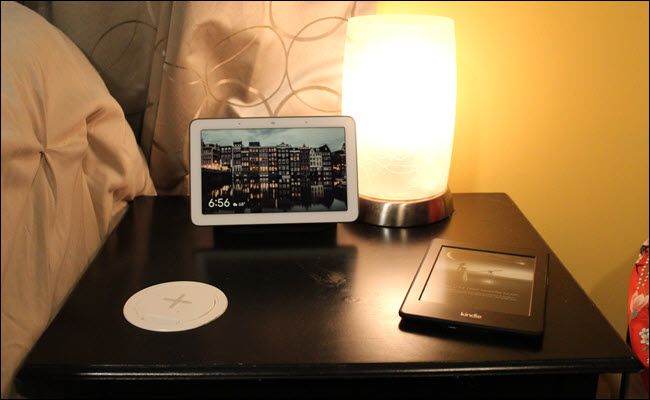Quick Links
You may spend most of the time in your bedroom sleeping, but it can still benefit from smarthome technology. A smarter bedroom can help you get to sleep and wake up in the morning.
Why a Smart Bedroom?
Bedrooms are a unique room in your living space, you spend a great deal of time in it, but most of that is usually spent sleeping. Adding smarthome technology can enhance a bedroom, so long as you think through your choices. With a few devices, you can make your bedroom more comfortable for sleeping and relaxing. A smart display, lights, smart shades, and smart plugs can help you get to bed and wake up feeling refreshed.
Add Smart Lights to Start and End the Day
Sometimes you're like to relax in the bedroom before you're want to sleep. So you might read or watch TV in bed. The problem is when you're ready to go to sleep, the light switches may be out of reach. Or the lights may be too bright for your spouse or partner.
Smart lights are great for control from the comfort of your bed. You can create timers, turn them on and off with your voice or phone, and if you use smart bulbs, you can dim the or change colors to something less harsh for the evening. And with a few routines, you can create a sunrise effect without having to buy an expensive clock.
And if you have a large headboard, you can add ambient light by running LED strips around the back of it. You can do the same with a TV in your bedroom.
For smart bulbs and LED strips, we recommend Philips Hue for a few reasons. They run off Zigbee, so are less likely to interfere with your Wi-Fi devices. Philips Hue is compatible with both Alexa and Google Assistant. The Hue app has a built-in wakeup routine that takes care of the sunrise feature without the need for setting up multiple routines. And you can pair your Hue lights with a Lutron Aurora light switch, which slips over your standard light switches.
The main issue with Philips Hue is the cost. A starter kit with two white bulbs and a hub will set you back $70. For the cost, you do get a better class of bulb, usually brighter and more vivid if you buy color bulbs. Hue bulbs also utilize Zigbee, which means they work even when the internet is down. Other smart bulbs may rely on Bluetooth or Wi-Fi, and so may come with range issues or lose their intelligence when the internet goes down. But if you want to save money, we've also gathered cheaper alternatives you may want to consider.
Smart Shades Can Cut the Lights Down
Once you have your lights taken care of, you may want to consider taking the other source of light in your bedroom: your windows. Smart shades are similar to smart lights: you can live without them, and they don't provide a crucial function. But once you have them, you may not want to live without them again.
You can not only raise and lower shades with your voice or phone, but you can create timers and routines that take care of them for you. Your routine could raise the shades when it's time to get up or lower them as part of a "good night" protocol. That's the power of smarthomes; one command can take care of many things.
Lutron's Serena Shades work well and are compatible with Alexa, Google Assistant, and even Apple Watches. But they're expensive, often going for hundreds of dollars.
If you'd like to spend less, you may want to keep an eye out for Ikea's Fyrtur shades . While the company won't release them until October, the price will range between $129 and $179 depending on size, far cheaper than most competing products. And they'll be compatible with both Alexa and Google Assistant.
Consider a Voice Assistant with a Display
Bedrooms usually have an alarm clock, but you can upgrade to something better. A smart display can control your other smart products throughout the house, and provide information like weather and calendar appointments.
You can use a voice assistant without a display, but you'll miss out a clock you can read, and other visual information. Sometimes it's just quicker to read your calendar appointments than listen to them one by one, for instance.
Amazon offers both the Echo Show and Spot, and of the two, the Spot is better suited to bedrooms. It's smaller and designed to mimic an alarm clock, which helps it fit right in your bedroom.
But we prefer Google's Nest Hub. Unlike the Echo devices, the Nest Hub lacks a camera, which adds a sense of privacy in your bedroom. And it doubles as a digital photo frame, a feature we love. The Home Hub also does a better job of dimming its screen than the Spot, a feature you may appreciate if you prefer a pitch black room when you sleep.
If you'd rather have Google Assistant, but in a clock-like format, like Amazon's Spot, our sister site Review Geek calls the Lenovo Clock nearly perfect. At $80, it's nearly half the price of the Nest hub, smaller, and again ditches the camera for more privacy in the bedroom.
If you're all in on one ecosystem or the other, that ultimately should guide your decision on which device to buy.
Use Smart Plugs For All Your Dumb Stuff
Your bedroom likely has a myriad of electronics, whether that be chargers, fans, heaters, humidifiers, or TVs. Smart plugs are a great way to give those devices intelligence without having to buy a new TV or rewire an outlet.
Smart plugs are easy to set up too; just plug one into an electrical outlet and then plug something into it. You'll need to set it up with an app and then connect it to Google Assistant or Alexa, but once you do, you'll have phone and voice control.
They're also a great option if you like to go to sleep with a fan or space heater running, but don't want them to run the entire night. And used correctly, smart plugs can potentially save you money. If you have a habit of leaving a humidifier running all day, a simple timer can take care of that problem.
With smart plugs, you don't always need to buy a whole new device to give what you have intelligence and voice control. We've covered several inexpensive options in the past that may be cheaper than buying a new heater, for instance. Before you buy a smart plug, you should turn your devices on, unplug them, then plug them back in. If they don't turn on and start working automatically, they're not suited for a smart plug.
Rounding out the Bedroom
Some smarthome tech might not be physically present in the bedroom. While a smart thermostat may not save you money, the convenience of changing the set temperature from the comfort of your bed is something you'll appreciate at three in the morning. Both Nest and Ecobee offer temperature sensors, and it may help to place one in the bedroom. Depending on which model of thermostat you choose, and how many sensors you want, you'll spend somewhere between $180 and $350 outfitting your house.
And you may want to consider adding conveniences to your bedroom that doesn't fall precisely into the smarthome category. Wireless chargers are great when the lights are low, and trying to find the charging port on your phone is difficult. We like charging pads that sink into a nightstand, which reduces both wire and surface clutter. All you need is a hole saw and a drill, and a nightstand that will let you run the cord to an outlet from below the top surface. Wireless chargers are relatively inexpensive as well, usually around the $20 mark. You may need to provide your own wall adapter though.
The one bedroom specific smart device we don't suggest is Zigbee fans. Currently, the best-known fans are designed to work with Wink, a smart hub we don't recommend anymore. Even if you're comfortable taking that risk, the Alexa integration only gives you voice control of the built-in light. You have to control all fan operations from the included remote or Wink app. You may as well save money and buy a fan with a remote control.
Not all suggestions are perfect for every bedroom. Take stock of your situation and stick with just the smarthome tech that works well for your bedroom. Remember, the goal is to add convenience, not problems, and frustration.

